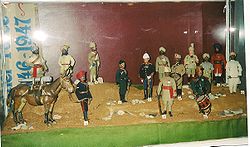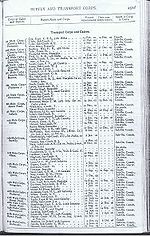Mule Corps
Mules formed part of the supply and transport section of armies and were particularly popular with expeditionary forces which had to travel over rougher terrain. A mule driver is called a muleteer.
Contents
Mule Corps of the Indian Army
Prior to 1884 no permanent transport department was established in the Indian Army and animals, carts and drivers were hired locally when required. Between 1884 and 1887 a separate transport corps existed. This became known as the Commissariat Transport Department and was under the control of the Military Department.
However by 1905 a further reorganisation had witnessed the emergence of a regular corps and cadres of mules, camels and cart transport. "This now consists of 21 mule corps, 9 silladar camel cadres and 2 pony cart train cadres. A mule corps is commanded by a British officer and is divided into two subdivisions, each in charge of a warrant officer. Those for cavalry brigades are divided into six draught and four pack troops , each under a daffadar and have a total strength of 552 all ranks, with 936 mules. Those for use wih other arms are divided into nine pack troops, each under a daffadar, and have a total strength of 388 of all ranks with 840 mules. Cadres of mule corps are commanded by a British Officer and maintain practically the full number of supervising and artificer establishments. They have, however, a much smaller number of mules." [1]
Fibiwiki article on Mountain Guns describes the artillery that could be carried by mules
The mule corps played an integral part in the various theatres of war during the First World War such as France, Gallipoli, Egypt and Basra.
Records
Details of where the individual sections of the Mule Corps were based each year are included in the annual Indian Army Lists under the section entitled "Supply and Transport Corps". (An example page from 1905 is shown).
External links
- Britsh Army Transport Animals Excellent article by Clive Elliott containing lots of background information about the roles played by army mules with accompanying photos and diagrams.
Historic books online
- On Two Fronts - Being the adventures of an Indian Mule Corps in France and Gallipoliby Major H M Alexander DCO 1917 archive.org
- "Mule Transport in Persia" by C E Biddulph page 407 The United Service Magazine Volume 8 New Series October 1893 to April 1894 Archive.org. Mules were purchased in Persia by the Indian Transport Department.

